If you want to restore the shine to your copper items, you can use eco-friendly copper polish solutions that work well and protect your health. You can try simple options like lemon with salt, vinegar, or baking soda. You can also find plant-based products in stores. These methods keep your home safe and help the environment. You can clean copper easily and avoid harsh chemicals by choosing these green solutions.
Key Takeaways
- Clean copper with natural things like lemon, salt, vinegar, and baking soda. These are safe and work well. Eco-friendly copper polishes help the earth. They reduce harmful chemicals and prevent pollution. Natural cleaners are better for your health. They do not have strong acids or bad smells like some store cleaners. You can make copper polish at home. Use easy kitchen items and soft cloths or sponges. Clean copper often and store it properly. This stops tarnish and keeps it shiny longer. Do not use strong chemicals, steel wool, or rough brushes. These can hurt copper’s surface and details. Pick store polishes with plant-based, biodegradable ingredients and eco-friendly labels. Clean copper jewelry softly. Use baking soda and lemon or vinegar paste. This keeps it shiny and does not harm it.
Table of Contents
Why Eco-Friendly Copper Polish
Environmental Benefits
Eco-friendly copper polish helps the Earth. Regular copper cleaners have strong chemicals. These can hurt water and soil. Eco-friendly polish uses safe, natural things. These break down in nature without harm. Some use waste like eggshells or sewage sludge. This turns trash into something useful. It also takes copper ions out of dirty water very well. Pollution stays low with these methods. You use fewer bad chemicals and less energy. Eco-friendly polish helps keep the world clean by:
- Using waste to make new things
- Taking copper ions out of water almost completely
- Keeping copper from leaking back into nature
- Letting things be used again and again to save resources
- Using less energy and fewer chemicals to make the polish
When you pick these, you help stop pollution and make waste useful.
Health and Safety
It is important to stay safe when cleaning copper. Many store-bought polishes have strong acids or ammonia. These can bother your skin, eyes, and lungs. Natural copper polish does not have these risks. Lemon, vinegar, and baking soda are safe to use. You do not have to worry about bad fumes or burns. Kids and pets are safer with natural cleaners. You also lower the chance of allergies. Simple kitchen items keep your home safe and clean.
Chemical vs. Natural
You can pick chemical or natural copper polish. Chemical ones work fast but can leave harmful stuff behind. They might also hurt the copper after a while. Natural polish uses things like lemon, salt, or vinegar. These clean gently and do not scratch copper. You can make them at home with what you have. Natural polish washes off easily and does not pollute water. Your copper shines without the dangers of harsh chemicals. Picking natural polish is good for you and the planet.
Essential Tools and Ingredients

Basic Supplies
You do not need special tools to clean copper. Most things you need are in your kitchen. Here is a simple list to help you begin:
- Get the same amount of salt and flour. These help scrub gently.
- Pour in some white vinegar. This helps remove tarnish.
- Mix salt, flour, and vinegar to make a smooth paste.
- Use a soft cloth or sponge to put the paste on your copper.
- Leave the paste on for a few minutes so it can work.
- Wash the copper with water to get rid of the paste.
- Dry the copper right away with a soft towel to stop water spots.
Tip: Always use soft cloths or sponges. Hard brushes can scratch copper.
You can use these steps for most homemade copper polishes. The supplies are safe and easy to find. You also skip strong chemicals that can hurt you or the planet.
Natural Ingredients
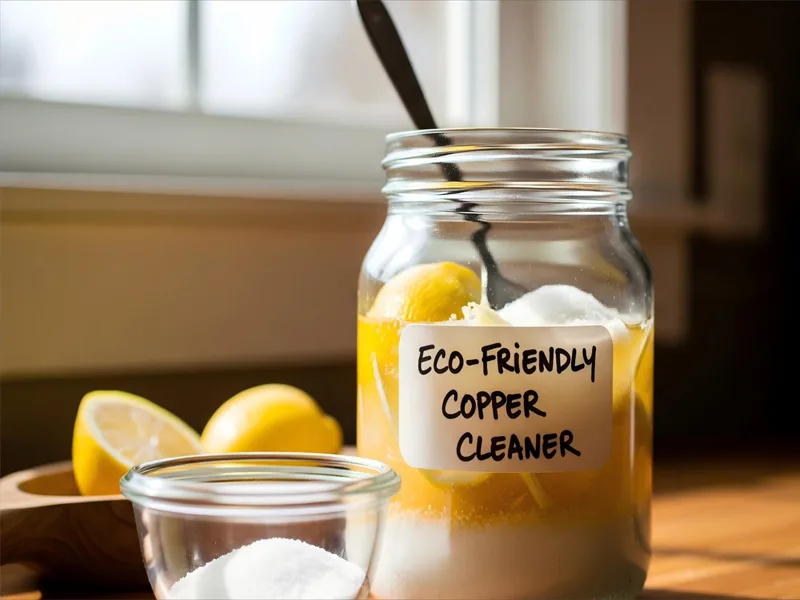
Many natural things can clean copper well. Each one works in its own way. Some clean fast, while others are gentle. The table below shows common natural ingredients and how they help:
| Natural Ingredient(s) | Cleaning Mechanism / Effectiveness | Suitable For / Notes |
|---|---|---|
| Lemon and Salt | Citric acid reacts with tarnish; salt acts as gentle abrasive to remove light to moderate tarnish | Quick cleaning; effective for light to moderate tarnish |
| Tamarind Pulp or Tomato Pulp | Natural acidity breaks down oxidation and restores warm glow | Restores shine; preferred natural kitchen ingredients |
| Baking Soda and Vinegar | Fizzing reaction lifts grime and tarnish | Deep cleaning; use cautiously on delicate or tin-lined utensils |
| Flour, Salt, and Vinegar Paste | Gentle polishing; lifts grime slowly without abrasion | Ideal for antique or intricately designed items; gentle on details |
| Ash or Multani Mitti (Fuller’s Earth) | Traditional cleaning agent used in Ayurvedic home care | Sustainable, traditional method |
You can pick the best natural ingredient for your copper. Lemon and salt are good for quick cleaning. Flour, salt, and vinegar paste are gentle and protect details. Baking soda and vinegar help with tough stains. These natural choices keep your copper shiny and safe for your family.
Eco-Friendly Copper Polish
Homemade Copper Polish
You can make copper polish at home. These ways use safe and natural things. You do not need strong chemicals. Most of the items are in your kitchen.
Lemon and Salt
Lemon and salt work well as a team. Lemon has acid that helps remove tarnish. Salt is a gentle scrubber. Here is how you use this polish: 1. Cut a lemon in half. Sprinkle salt on the cut side. 2. Rub the lemon with salt on the copper. 3. Let the juice and salt stay for 10 to 15 minutes. 4. Rinse the copper with warm water. 5. Dry and shine it with a soft cloth.
Tip: Always use a soft cloth so you do not scratch your copper.
Vinegar and Flour
Vinegar and flour make a soft paste. This polish is good for items with small details. 1. Mix the same amount of salt and white vinegar in a bowl. 2. Add flour until you get a thick paste. 3. Put the paste on the copper with a soft cloth. 4. Let it stay for 15 to 30 minutes. 5. Wash off the paste with water. 6. Dry and shine with a clean cloth. This way uses natural things and is gentle for delicate pieces.
Baking Soda Paste
Baking soda is a soft cleaner. You can use it to make a simple polish. 1. Mix baking soda with a little water to make a paste. 2. Put the paste on the copper with a soft sponge. 3. Rub gently in circles. 4. Let it stay for 10 minutes. 5. Wash with water and dry with a soft towel. This way removes tarnish but does not scratch the copper.
Ketchup and Alternatives
Ketchup has vinegar and tomato acid. These help clean copper. You can use ketchup for a quick polish. 1. Squeeze ketchup onto the copper. 2. Spread it with your fingers or a cloth. 3. Let it stay for 10 to 15 minutes. 4. Wash with warm water. 5. Dry and shine with a soft cloth. You can also use tomato paste or tamarind pulp instead. These natural choices work similarly.
Store-Bought Copper Polish
You can buy special copper polish in stores. Many brands now have eco-friendly copper polish. These use plant or mineral ingredients. They do not use strong chemicals and are better for the Earth.
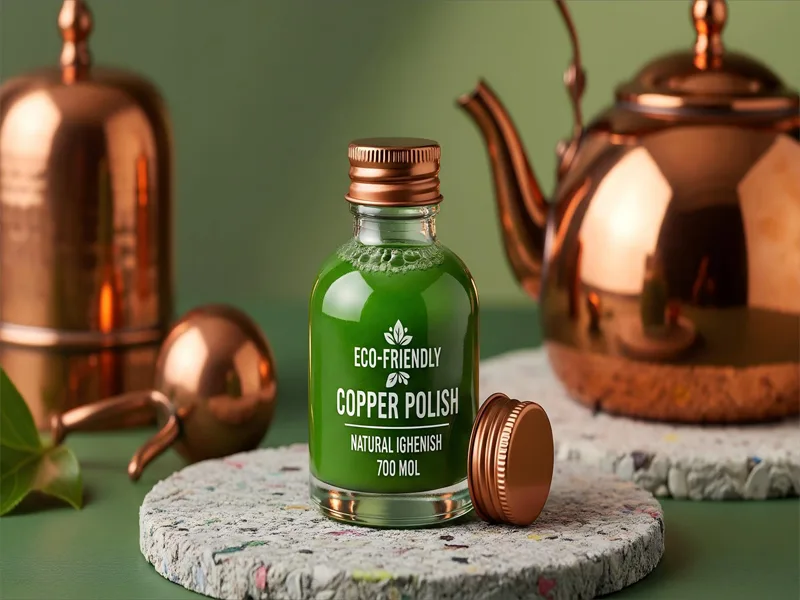
Natural Product Options
The table below lists some popular copper polish products. These brands use safe, natural things and have eco-friendly labels.
| Brand | Certifications | Eco-Friendly Ingredients/Attributes | Environmental Benefits/Notes |
|---|---|---|---|
| Earth Friendly Stainless Steel Cleaner | EPA Safer Choice | Plant-based, biodegradable formula; no phosphates, ammonia, or synthetic fragrances | Greywater and septic safe; non-toxic; works on copper and other metals |
| ECOS Stainless Steel Cleaner | Cruelty-free certified | Plant-derived surfactants; no toxic ingredients | Carbon-neutral facilities; works on copper; reduces cleaning frequency |
| All-Clad Specialty Powder | N/A | Natural minerals; less abrasive than other products | Environmentally safe; effective on copper and stainless steel |
These special products help you clean copper safely. You keep yourself and the planet safe when you use these.
How to Choose
When you pick a store-bought copper polish, look for these things: – Plant or mineral ingredients – No phosphates, ammonia, or fake smells – Labels like EPA Safer Choice or cruelty-free – Biodegradable and non-toxic formulas. You can read the label to see if it is safe for the Earth. These products work well and keep your home safe. You can use them for copper pots, jewelry, or decorations.
Note: Always follow the directions on the product label for the best results.
How to Clean Copper
Preparation Steps
Before you start to clean copper, gather all your supplies. You need a soft cloth, a gentle sponge, and your chosen eco-friendly cleaner. You can use a combination of lemon and salt, vinegar and flour, or a baking soda paste. Make sure your copper item is free from dust or loose dirt. Rinse it with warm water and dry it with a towel. This helps the cleaner work better.
Check your workspace. Open a window or turn on a fan for fresh air. Wear gloves to protect your hands. Always read the label if you use a store-bought cleaner. Never mix different cleaning agents. This can create harmful fumes. Keep your tools and cleaners ready before you begin.
Tip: Use only non-toxic, eco-friendly products. This keeps you and the environment safe.
Application Techniques
Now you can start to clean the copper. Pick one of the natural ways to clean copper. For lemon and salt, cut a lemon in half and sprinkle salt on it. Rub the lemon on the copper surface. For vinegar and flour, mix equal parts of salt and vinegar, then add flour to make a paste. Spread the paste on the copper with a soft cloth. For baking soda paste, mix baking soda with water and apply it gently.
Rub the cleaner in small circles. Cover all tarnished spots. Do not use too much pressure. This prevents scratches. Let the cleaner sit for 10 to 30 minutes, depending on the method. Always follow the instructions for your chosen way to clean copper.
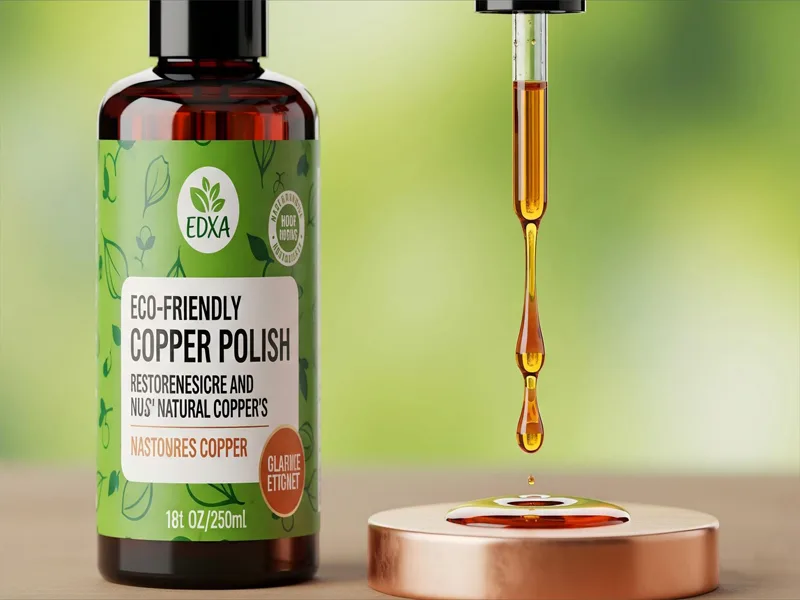
Here are some common mistakes to avoid when you clean copper:
- Do not use too much citric acid. High amounts can damage copper.
- Always rinse the copper well after cleaning. Leftover cleaner can cause tarnish.
- Dry the copper fully with a soft cloth. This stops water spots.
- Do not use harsh chemicals. Natural cleaners work well and are safe.
Note: Wear gloves and a mask if you have sensitive skin or allergies.
Rinsing and Buffing
After you clean the copper, rinse it under warm running water. Make sure you remove all traces of the cleaner. This step is important. Any leftover cleaner can cause new stains or tarnish. Use your hands or a soft sponge to help rinse off the paste or residue.
Next, dry the copper right away. Use a clean, soft towel. Buff the surface in gentle circles. This brings out the shine and prevents water spots. If you see any dull areas, repeat the cleaning process. Sometimes, you need to clean copper more than once for the best results.
You now know how to clean copper using safe, eco-friendly methods. These steps help you keep your copper bright and beautiful. Choose natural ways to clean copper for a healthy home and a cleaner planet.
Natural Ways to Clean Copper
Quick Recipes
You can clean copper using simple items from your kitchen. These natural ways to clean copper help you avoid harsh chemicals. You can try these quick recipes to remove tarnish and bring back the shine.
- Lemon and Salt Scrub
Cut a lemon in half. Sprinkle salt on the cut side. Rub the lemon on the copper surface. The acid in the lemon and the salt work together to remove tarnish. Rinse with warm water and dry with a soft cloth. - Vinegar and Baking Soda Paste
Mix equal parts of vinegar and baking soda to make a thick paste. Spread the paste on the copper. Let it sit for ten minutes. Scrub gently with a soft sponge. Rinse and dry well. This method helps clean copper and remove tarnish quickly. - Ketchup Cleaner
Squeeze ketchup onto the copper item. Spread it with your fingers or a cloth. Wait for ten minutes. Wipe off the ketchup and rinse with water. Dry the copper right away. The acids in ketchup help clean and remove tarnish. - Flour, Salt, and Vinegar Polish
Mix one tablespoon of flour, one tablespoon of salt, and one tablespoon of vinegar. Make a smooth paste. Apply it to the copper. Let it sit for fifteen minutes. Rinse and buff with a clean towel.
Tip: Always test a small spot first. Some natural ways to clean copper may work better on certain items.

Tips for Best Results
You want your copper to look its best. Follow these tips to clean copper safely and get a bright finish every time.
- Use soft cloths or sponges. Hard brushes can scratch copper.
- Rinse the copper well after you clean it. Leftover cleaner can cause new stains.
- Dry the copper right away. Water spots can dull the shine.
- Clean copper often. Regular cleaning stops tarnish from building up.
- Store copper in a dry place. Moisture can make tarnish return faster.
- Wear gloves if you have sensitive skin. Some natural ingredients can irritate your hands.
- Avoid mixing different cleaners. Stick to one recipe at a time.
Remember: The best ways to clean copper use gentle, natural ingredients. You protect your health and the environment when you choose these methods.
You can keep your copper bright and beautiful with these easy steps. Try different recipes to see which one works best for your items. Clean copper regularly to prevent tarnish and enjoy the warm glow of your favorite pieces.
Polish Copper Jewelry
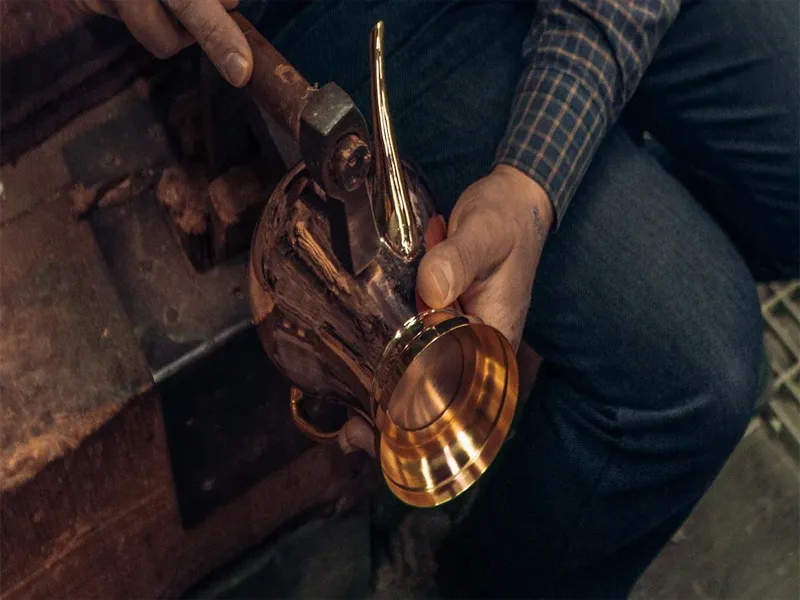
Safe Methods
You want your copper jewelry to shine and last a long time. You can polish copper jewelry at home using safe and natural methods. Start by gathering a few simple items from your kitchen. You need lemon juice or distilled white vinegar, baking soda, a soft toothbrush, and a soft cloth.
To polish copper jewelry, mix a small amount of baking soda with lemon juice or vinegar. This mixture will bubble and form a gentle paste. Dip the toothbrush into the paste and gently clean the jewelry. Move the brush in small circles to reach every part. Let the paste sit on the jewelry for about 30 minutes. This step helps break down tarnish and dirt.
After waiting, rinse the jewelry under warm water. Make sure you remove all the paste. Dry the piece right away with a soft cloth. Buff the surface to bring out the shine. You can repeat this process if you see any dull spots. Always use gentle pressure when you polish copper jewelry. Hard scrubbing can scratch the metal.
Tip: Never use undiluted vinegar or alcohol-based cleaners. These can damage your jewelry and make it lose its shine.
Maintenance Tips
You can keep your jewelry looking bright and beautiful with a few easy habits. Experts recommend these steps to help you polish copper jewelry and prevent tarnish:
- After each time you wear your jewelry, wipe it with a soft or jeweler’s cloth. This removes smudges and body oils that can dull the shine.
- Store your jewelry in a dry place. Avoid bathrooms or other humid areas. Moisture can cause tarnish to form quickly.
- Separate your copper pieces from other metals before storing them. This prevents reactions that can change the color or finish.
- Use anti-tarnish bags or wrap each piece in a soft cloth. This helps stop oxidation and keeps your jewelry looking new.
- When you clean copper jewelry, always use a gentle paste made from baking soda and lemon juice or vinegar. Apply it with a soft toothbrush, let it sit, then rinse and dry.
- Do not use undiluted vinegar or alcohol-based cleaners. These can harm the surface and make it harder to polish copper jewelry in the future.
Note: Regular care makes it easier to polish copper jewelry and keeps it looking its best.
You can enjoy your favorite pieces for years if you follow these simple steps. Clean your jewelry often, store it with care, and use gentle methods every time you polish copper jewelry.
Maintain Copper Shine
Prevent Tarnish
You can keep your copper looking bright by using a few simple habits. Moisture is one of the main reasons copper loses its shine. Always dry your copper items right after washing them. If you wear copper jewelry, remove it before swimming, showering, or exercising. Sweat and water can speed up tarnishing. Use a soft cloth to dry your copper within five minutes if it gets wet.
Choose gentle, pH-neutral soaps when you clean copper. Harsh chemicals and strong cleaners can damage the surface and make it tarnish faster. Test new lotions or sprays on a small area before using them near copper. Avoid exposing copper to salt water, chemicals, or extreme temperatures. Store your copper in a cool, dry place away from sunlight and humidity. These steps help prevent tarnish and keep your copper shining longer.
Tip: Use a soft microfiber cloth or a baby toothbrush for gentle cleaning. This protects the finish and helps prevent copper from tarnishing.
Regular Care
Regular care keeps your copper looking its best. You do not need to clean copper every day. Dust your items with a soft cloth to remove fingerprints and dirt. Clean only when you see tarnish or dull spots. Over-cleaning can wear down the natural patina, which gives copper its unique look.
When you clean copper, use natural products like lemon juice, vinegar, or baking soda. These gentle cleaners remove tarnish without scratching the surface. Avoid abrasive pads or harsh chemicals. For stubborn tarnish, soak the item in a mix of vinegar and salt, then rinse and dry well. Patience and gentle care help you maintain the shine and value of your copper.
A simple cleaning schedule can help you prevent tarnish:
- Wipe copper after each use.
- Clean with mild soap every few weeks.
- Polish with a soft cloth to restore shine.
Storage Tips
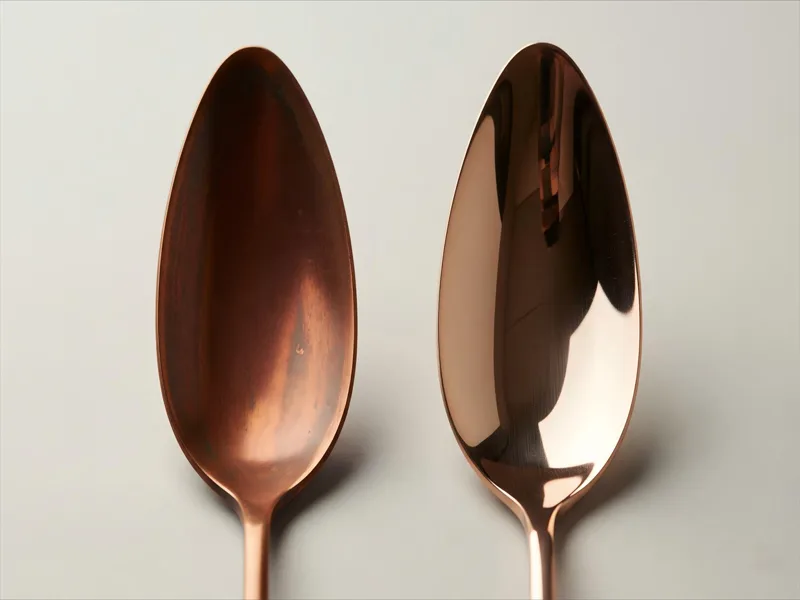
Proper storage is important if you want to keep your copper bright. Store copper in a dry place, away from bathrooms or kitchens where moisture is common. Wrap each piece in a soft cloth or use anti-tarnish bags. This keeps air and humidity away from the surface.
Keep copper items separate from other metals. Mixing metals can cause reactions that lead to tarnish. If you have copper jewelry, store it in a jewelry box with a silica gel packet to absorb moisture. For larger items, place them in a cabinet or drawer lined with a soft cloth.
You can also apply a thin layer of wax or lacquer to your copper. This protective coating helps prevent tarnish and keeps your items shiny for longer. Always check the coating every few months and reapply if needed.
Note: Good storage habits make it much easier to prevent tarnish and keep your copper looking beautiful year after year.
You have many safe and eco-friendly ways to polish copper. Lemon, salt, vinegar, and baking soda work well for most items. Store-bought plant-based products also give great results.
- Choose natural, non-toxic methods to protect your health and the planet.
- Make copper care a regular habit for lasting shine.
Share your favorite tips or recipes in the comments. Your experience can help others keep their copper bright and beautiful.
FAQ
You can use a combination of lemon and salt, vinegar and flour, or a baking soda paste. These natural ingredients clean copper without harsh chemicals. Always use a soft cloth or sponge to avoid scratches.
Yes, you can use natural polishes like lemon, vinegar, or baking soda on copper pots and pans. Rinse well after cleaning. Dry the cookware right away to prevent water spots.
You should clean copper when you see tarnish or dull spots. For best results, wipe your copper with a soft cloth after each use. Regular care keeps copper shiny and prevents heavy tarnish.
Natural polishes are gentle. You can use them on delicate or antique copper. Always test a small area first. Avoid scrubbing too hard to protect fine details.
Yes, you can use plant-based or mineral-based copper polish on jewelry. Check the label for non-toxic ingredients. Rinse and dry jewelry well after cleaning.
Copper reacts with air and moisture. This reaction causes tarnish. Humid places and contact with water speed up the process. Store copper in a dry place to slow tarnish.





